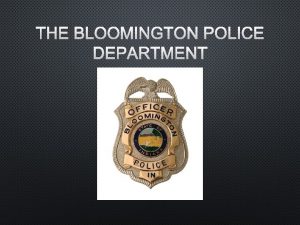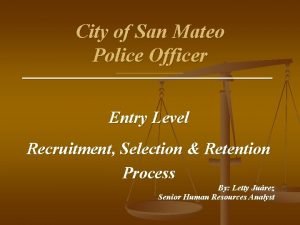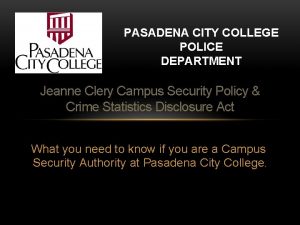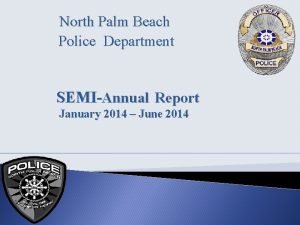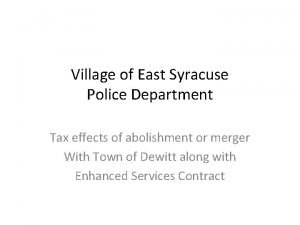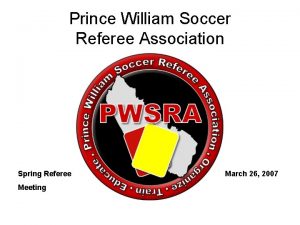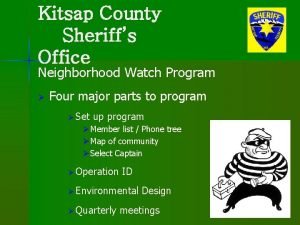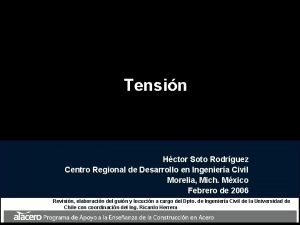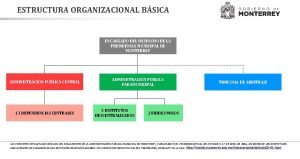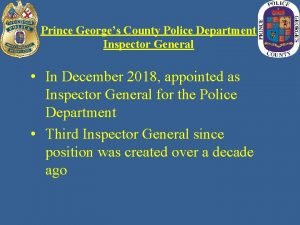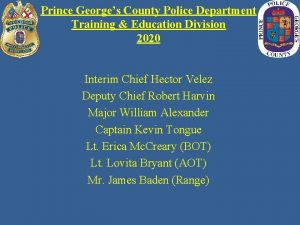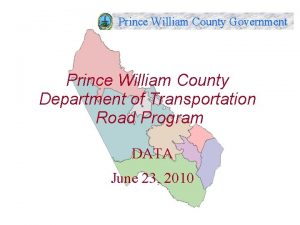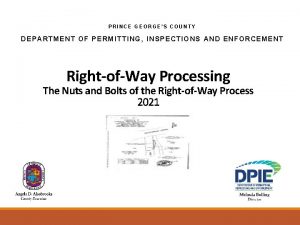Prince Georges County Police Department Interim Chief Hector




















































- Slides: 52

Prince George’s County Police Department Interim Chief Hector Velez

Prince George’s Police Department Civilian Positions by Race Civilian Positions with Race/Gender Account Clerk 3 P Black Account Clerk 4 P Black Administrative Aide 1 P Hispanic White Administrative Aide 2 P Black White Administrative Aide 3 P # of Civilians % of Parent Row 1 0. 30% 1 100. 00% 2 0. 61% 2 100. 00% 2 0. 61% 1 50. 00% 12 3. 65% 7 58. 33% 5 41. 67% 18 5. 47% Black 11 61. 11% White 7 38. 89% Administrative Aide 4 P 5 1. 52% Black 3 60. 00% White 2 40. 00% Administrative Assistant 1 G Black Administrative Assistant 2 P 1 0. 30% 1 100. 00% 7 2. 13% Black 2 28. 57% White 5 71. 43% Administrative Assistant 3 P Black Administrative Specialist 2 G White Administrative Specialist 3 G 2 0. 61% 2 100. 00% 4 1. 22% Black 2 50. 00% White 2 50. 00% Administrative Specialist 4 G Black Audio Visual Specialist 2 P White Audio Visual Specialist 3 P White Budget Management Analyst 1 P Black Budget Management Analyst 3 P Black Citizens Services Specialist 3 G White 1 0. 30% 1 100. 00% 2 0. 61% 2 100. 00% 1 0. 30% 1 100. 00% Clerk Typist 2 P 1 0. 30% Hispanic 1 100. 00% Communications Specialist 2 P White Community Affairs Assistant 2 P 1 0. 30% 1 100. 00% 1 0. 30%

Prince George’s Police Department Civilian Positions by Race Hispanic Community Developer 3 G Black Data Entry Operator 2 P Black Data Preparation Supervisor-P Black Executive Administrative Aide-P Black Firearms Examiner-P White Firearms Technician-P White Forensic Chemist 1 P 1 100. 00% 1 0. 30% 1 100. 00% 3 0. 91% 3 100. 00% 1 0. 30% 1 100. 00% 2 0. 61% Hispanic 1 50. 00% White 1 50. 00% Forensic Chemist 2 P 8 2. 43% Asian 2 25. 00% Black 1 12. 50% White 5 62. 50% Forensic Chemist 3 P Asian Forensic Latent Print Examiner 2 P 1 0. 30% 1 100. 00% 2 0. 61% Black 1 50. 00% White 1 50. 00% Forensic Latent Print Examiner 4 G Black General Clerk 1 P Black General Clerk 2 P White General Clerk 3 P 1 0. 30% 1 100. 00% 2 0. 61% 1 50. 00% Hispanic 1 50. 00% General Clerk 4 P 48 14. 59% American Indian/Alaskan Native 1 2. 08% Asian 2 4. 17% Black 36 75. 00% White 9 18. 75% Black Human Resources Analyst 2 P Hispanic Human Resources Analyst 3 P 1 0. 30% 1 100. 00% 2 0. 61% Black 1 50. 00% White 1 50. 00% Human Resources Analyst 4 G White Human Resources Assistant 3 P Black Info Tech Manager 2 G 1 0. 30% 1 100. 00% 1 0. 30%

Prince George’s Police Department Civilian Positions by Race White Info Tech Proj Coord 2 G Black Investigator 1 G 1 100. 00% 1 0. 30% 1 100. 00% 2 0. 61% Black 1 50. 00% White 1 50. 00% Investigator 1 P 2 0. 61% Asian 1 50. 00% White 1 50. 00% Investigator 2 G 2 0. 61% 1 50. 00% White 1 50. 00% Investigator 2 P 16 4. 86% Black Asian 1 6. 25% Black 3 18. 75% 75. 00% White 12 Investigator 3 P 2 0. 61% White 2 100. 00% Laboratory Manager-G 2 0. 61% White 2 100. 00% Law Clerk 2 G 1 0. 30% White 1 100. 00% Personal Serv Contract-3050 T Black Personal Serv Contract-3050 T 0002 White Planner 5 G White Police Cadet 2 G 3 0. 91% 3 100. 00% 1 0. 30% 1 100. 00% 6 1. 82% Black 2 33. 33% Hispanic 2 33. 33% White 2 33. 33% Programmer-Systems Analyst 1 G White Programmer-Systems Analyst 2 P 1 0. 30% 1 100. 00% 2 0. 61% Black 1 50. 00% White 1 50. 00% Psychologist 2 G White Psychologist 3 G Black Public Information Officer 2 G Hispanic Public Safety Emergency Call Taker 2 P 2 0. 61% 2 100. 00% 1 0. 30% 1 100. 00% 11 3. 34% Black 9 81. 82% Hispanic 1 9. 09% White 1 9. 09% Public Safety Emergency Call Taker 3 P Black 3 0. 91% 1 33. 33%

Prince George’s Police Department Civilian Positions by Race Hispanic 1 33. 33% White 1 33. 33% Public Safety Emergency Dispatcher 2 P Black School Crossing Guard 1 0. 30% 1 100. 00% 84 25. 53% Asian 1 1. 19% Black 70 83. 33% Hispanic White Security Officer 1 P Black Security Officer 2 P 1 1. 19% 12 14. 29% 3 0. 91% 3 100. 00% 9 2. 74% Black 4 44. 44% White 5 55. 56% Security Officer 3 P 1 0. 30% 1 100. 00% 3 0. 91% Black 1 33. 33% White 2 66. 67% White Supervisor School Crossing Guard-G Supervisory Clerk-P Black Supply Technician-P Black Supply-Property Clerk 2 P Hispanic Supply-Property Clerk 4 P 2 0. 61% 2 100. 00% 1 0. 30% 1 100. 00% 12 3. 65% Asian 1 8. 33% Black 3 25. 00% White 8 66. 67% Weapons Instructor 2 P 5 1. 52% Asian 1 20. 00% Black 1 20. 00% White 3 60. 00% Weapons Instructor Supervisor - G White Grand Total 1 0. 30% 1 100. 00% 329 100. 00%

Prince George’s Police Department Civilian Positions by Race Civilians by Race/Gender American Indian/Alaskan Native # of Employees % of Total 1 0. 31% 10 3. 80% Female 5 2. 07% Male 5 1. 73% 190 61. 35% 151 45. 86% Male 39 15. 49% Hispanic 13 6. 17% Female 8 4. 28% Male 5 1. 89% 115 28. 36% Female 66 17. 12% Male 49 11. 24% 329 100. 00% Female Black/Not Hispanic origin Female White/Not Hispanic origin Grand Total

Prince George’s County Police Department Police Civilians by Race and Gender

Prince George’s County Police Department Police Civilians by Race

Prince George’s County Police Department Police Civilians by Gender

Separation by Year Civilian and Police Years of Service FY 16 FY 17 FY 18 FY 19 FY 20 Grand Total 20 or more 66 44 61 66 68 305 less than 20 4 9 6 5 6 30 less than 15 7 10 8 21 11 57 less than 10 11 15 11 11 5 53 less than 5 9 6 2 10 13 40 less than 3 24 17 14 17 5 77 121 102 130 108 562 Grand Total

Separation by Year Civilian and Police



Statistical Data Information Technology Division Alan J. Lee Chief Information Officer

Calls For Service (CFS) • A Motorola CAD tracks each incident involving an officer. • There are hundreds of call types and the initial classification is based on best available information when the call is initiated. • There are times when the dispatched call type and the actual call type is different. – First point of correction is the use of call clearance codes.

Calls For Service (CFS)

Calls For Service (CFS)

Traffic Stops Jan – Aug 2020 Traffic Stops 20, 200 Jan – Dec 2019 Jan – Dec 2018 Jan – Dec 2017 Jan – Dec 2016 102, 425 102, 933 114, 166 109, 599

Crime • Crime data may be tracked using a variety of methods – FBI Uniform Crime Reporting should be the method utilized when comparing offenses between different jurisdictions – Maryland Annotated Code is useful when examining charging language – Internally we use a hybrid combination of the two which is based on a call clearance system.

Crime • Clearance codes are assigned by the responding officer on the scene and are composed of four characters. The first designates action taken, the next two refer to the crime and the final is an option special study code. – First character, 1 nothing was found or the call was cancelled, 3 officer responded and handled the call but no report was required, 5 a report was written, 7 an arrest was made, 9 an arrest warrant was served.

Crime • Clearance codes (cont’d) – Remaining characters reflect crime types • • • Homicide *64* Rape *65* Robbery *84* Assault *60* Burglary *62* Theft *63* Stolen Vehicle *05* Traffic Accident *09* Field Interview *07*

Crime Statistical Data • Violent crimes include homicide, forcible rape, robbery (commercial, residential, citizen), carjacking, and assault. • Property crimes include burglary (commercial, residential, other), all thefts and stolen vehicles. • PGPD tracks crime daily based on incidents handled by our officers, along with those municipalities where we handle follow-up investigative responsibility.

Crime Statistical Data

Crime Monitoring Tools Daily Crime Report

Crime Monitoring Tools Daily Crime Report

Crime Monitoring Tools Daily Crime Report

Crime Monitoring Tools Daily Crime Report

Crime Monitoring Tools Daily Crime Report

Crime Monitoring Tools Starlight • PGPD utilizes a web-based program to provide near real-time data, based on CFS. • Starlight provides alerts, maps, comparison screens, and both email and cell phone notifications for critical incidents.

Crime Monitoring Tools Starlight

Crime Monitoring Tools Starlight

Crime Monitoring Tools Starlight

Crime Monitoring Tools Starlight

Crime Monitoring Tools Starlight

Crime Monitoring Tools Public Open Data Portal

Body Worn Cameras Information Technology Division Alan J. Lee Chief Information Officer

Body Worn Cameras & Videos • Prior to March 2020 PGPD had deployed BWCs to 1 Patrol Squad in each of the 8 District stations, along with 2 of the Special Operations Division Traffic Enforcement Units. • Panasonic Arbitrator was the selected vendor due to the PGPD’s extensive use of their MVS. • Total of 89 BWCs deployed at that time.

Body Worn Cameras & Videos • In May 2020 PGSO “loaned” PGPD 100 additional BWCs to assist in deployment. A match number of BWCs will be returned to PGSO when large-scale procurement begins. • Before those BWCs could be issued multiple tasks had to be accomplished, i. e. purchase of charging bays & mounting clips, coordinate refresh of devices with Panasonic.

Body Worn Cameras & Videos • Backend storage for all videos is currently being upgraded from Unified Evidence Management Software (UEMS) to Unified Digital Evidence (UDE). UDE will allow for sharing of video links with access control. • PGPD has uploaded approx. 18, 000 videos since implementing UDE two months ago. • UEMS & UDE contain approx. 1. 55 million videos.

Body Worn Cameras & Videos • OHS is responsible for managing the Panasonic contract, which includes purchasing all BWCs. • It is anticipated that BWCs will begin arriving in the next few weeks & deployment will continue. • Plan is to deploy BWCs to all Patrol officers and Special Operations, which will equate to approx. 900 BWCs in use. • Timeframe for full deployment is by the end of the year.

United States Justice Department Investigation Deputy Chief Jackie Rafterry Major Steven Yuen Planning and Research Division

Introduction • In July 1999, the U. S. Department of Justice (DOJ) initiated an investigation of alleged misconduct by the Prince George’s County Police Canine Section. • The following year, in October 2000, DOJ initiated a broader investigation of an alleged pattern or practice of excessive force throughout the Police Department • In January 2004, DOJ and the Police Department entered into a Memorandum of Agreement (MOA) surrounding the pattern and practice investigation. The MOA set forth a number of benchmarks the Department was required to meet for compliance. • A third-party monitor was hired to oversee and ensure compliance with the MOA. • Also in January 2004, through the U. S. District Court, the Police Department entered into a “Consent Decree” in response to DOJ’s investigation of the Canine Unit.

Dual Department of Justice Investigations These dual investigations conducted by DOJ included an examination of the following allegations: • • Constitutional rights violations Use of excessive force Failure to adequately train, supervise and monitor officers Failure to adequately investigate, review and evaluate use of force incidents • Failure to adequately investigate alleged misconduct and impose discipline on those allegedly engaged in misconduct

Department of Justice Memorandum of Agreement The MOA was a voluntary agreement in which DOJ did not actually make a finding of wrongdoing on the part of the Police Department. Its purpose was to promote police integrity and prevent conduct that deprived persons of rights, privileges, and immunities secured or protected by the Constitution and laws of the United States. The agreement specifically addressed reformation of: • Responding to incidents involving mentally ill persons • Use of Force Policies, Evaluation, Documentation and Use of Force Review • Training • Investigation and Review of Misconduct Allegations • Management and Supervision • Monitoring, Reporting and Implementation

Department of Justice Consent Decree Similarly, the Consent Decree was a mediation agreement between DOJ and the Police Department, which was facilitated through the Court. The decree was specifically designed to address the alleged pattern or practice of excessive force utilized by officers within the Department’s Canine Section. Like the MOA, the decree did not include an admission of wrongdoing from the Department, nor a finding of wrongdoing by DOJ. It did, however, reflect the Department’s commitment to ensuring constitutional policing and fair treatment of citizens. The Consent Decree specifically addressed reformation of: • Canine Section Policy and Procedures • Accountability • Review of Canine Deployments • Training • Management and Supervision • Monitoring, Reporting and Implementation

Changes Made As a result of these pacts with DOJ, with DOJ’s guidance, Police Department developed and implemented new strategies, policies, procedures, and guidelines, many of which are still in place today and are continually examined to ensure best practices. Some examples of changes that were made include: • Enhancing the employee Early Identification System (EIS) • Strengthening the partnership with the Mobile Crisis Team. • Implementing mandatory officer training regarding handling incidents involving mentally ill persons. • Requiring supervisory approval prior to officers conducting Emergency Petitions • Enhancement of the Field Training Officer program and selection process • Ensuring accessible ways in which to file a complaint against police practices

Changes Made (cont. ) • Revising/implementing myriad use of force policies and procedures, including – Institution of annual training regarding use of force policies and tactics, – – – – including implementation of the “use of force continuum” and de-escalation techniques Creation a standard form and way in which to document use of force incidents Explicitly prohibiting officers from using choke holds or similar carotid holds Adding oversight to use of force reviews conducted by supervisors in order to ensure timely, thorough, and consistent investigations Creation of a special board to review all critical firearm discharges Revision of Canine Section policies and procedures Revision of policy regarding the use of Oleoresin Capsicum (OC) spray Creation of an Executive Review Panel to internally review serious use of force incidents and generate training topic and development of best practices therefrom

Termination of the Consent Decree • The U. S. District Court for the District of Maryland found that Prince George’s County and the Police Department had satisfied all of the prospective relief required by the Consent Decree to correct the alleged violations of federal rights by Prince George’s County and the Police Department • Based on this determination, the Court concluded that the County and Department had demonstrated, for a reasonable period of time, that compliance of the Consent Decree was made in good faith, past unlawful behavior had been eliminated to the extent practicable, and, therefore, the purpose of the Decree had been satisfied. • By Court Order, termination of the Consent Decree took place on March 11, 2007.

Expiration of Memorandum of Agreement • Similarly, in its January 15, 2009 final report, the Monitor asserted that the Police Department was in substantial compliance with the provisions of the MOA • As a result of this substantial compliance and progress made by Police Department, the Department of Justice agreed and deemed it appropriate to close its investigation. • Accordingly, the Memorandum of Agreement was allowed to expire on January 22, 2009.

Challenges and Successes

Challenges and Successes Challenges: • Hiring and retaining skilled civilian employees, particularly qualified skilled technical employees. ØDNA/ Drug Analyst ØLatent Print Examiners ØRecruiting and Retention ØTrying to hire officers that represent the racial makeup of Prince George’s County

Challenges and Successes: • The William French Smith Award for Outstanding contributions to cooperative Law Enforcement. • The Forensic Science Division has maintained accreditation through the American National Standards Institute National Accreditation Board (ANAB) ISO/IEC 17025 standards, including AR 3125. The Division has also maintained licensing through the Maryland Department of Health’s Forensic Laboratory Advisory Committee (FLAC), and the DNA Laboratory has maintained accreditation from the FBI through the Quality Assurance Standards for Forensic DNA Testing Laboratories. This included a full on-site assessment which took place between September 24 and 27, 2019. Additionally, the Division has made significant progress on the new Forensic Science Division Laboratories, which will enter the last phase of design later this month.
 Prince william county police report online
Prince william county police report online Prince hector
Prince hector Pefht
Pefht Chapter 9 lesson 3 commander in chief and chief diplomat
Chapter 9 lesson 3 commander in chief and chief diplomat Alcock v chief constable of south yorkshire
Alcock v chief constable of south yorkshire Department of the navy chief information officer
Department of the navy chief information officer Lathrup village police
Lathrup village police Little elm police reports
Little elm police reports Davidson police department
Davidson police department Mille lacs tribal police department
Mille lacs tribal police department Huntersville police department
Huntersville police department Umass lowell police
Umass lowell police Chain of police department
Chain of police department Bloomington indiana police department
Bloomington indiana police department San mateo police department jobs
San mateo police department jobs Flagler county sheriff office
Flagler county sheriff office Pasadena city college police department
Pasadena city college police department North palm beach police
North palm beach police East syracuse police department
East syracuse police department New canaan police department
New canaan police department Canton police officers
Canton police officers Backbone of police department
Backbone of police department Sparks nevada police department
Sparks nevada police department Prince george's county standard details
Prince george's county standard details Pg county zoning ordinance
Pg county zoning ordinance Casra referee
Casra referee Prince william county specialty programs
Prince william county specialty programs Kitsap county sheriff's office
Kitsap county sheriff's office Ventura county police academy
Ventura county police academy Hernandez garces hector ruben
Hernandez garces hector ruben Iliada de homero resumen
Iliada de homero resumen King henry doesn't usually drink
King henry doesn't usually drink Deka drank
Deka drank Hector garcia-molina junghoo cho
Hector garcia-molina junghoo cho Hector budman
Hector budman Y vuela como un manantial
Y vuela como un manantial Hector schmitz
Hector schmitz Letra amor de temporada
Letra amor de temporada Sister of paris and hector
Sister of paris and hector Hector novoa vasquez
Hector novoa vasquez King henry drank chocolate milk
King henry drank chocolate milk Hector infer
Hector infer Hector sky foodstuff trading llc
Hector sky foodstuff trading llc Hector xavier monsegur
Hector xavier monsegur Hector rubinstein
Hector rubinstein Aron hector schmitz
Aron hector schmitz Hector soto rodriguez
Hector soto rodriguez Hector garcia-molina junghoo cho
Hector garcia-molina junghoo cho Hector pieterson poem
Hector pieterson poem Mrs packletide's tiger author
Mrs packletide's tiger author Hector antuna sanchez
Hector antuna sanchez Biography of saki
Biography of saki Estructura organizacional de
Estructura organizacional de
